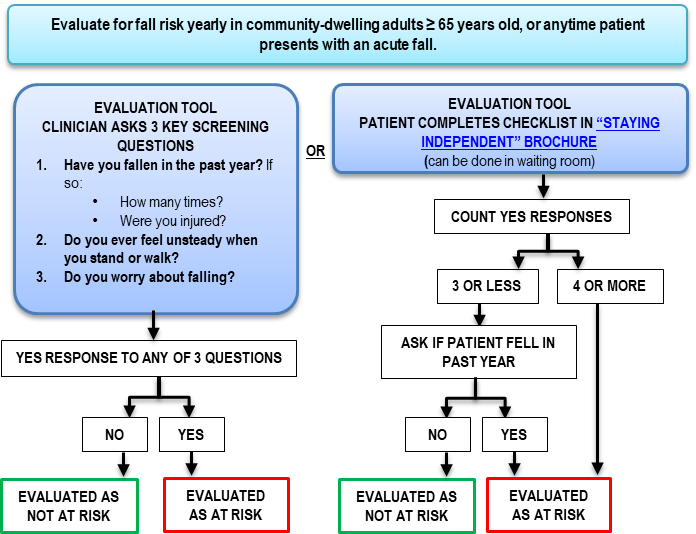The Buzz on Dementia Fall Risk
Table of ContentsDementia Fall Risk Things To Know Before You Get ThisOur Dementia Fall Risk StatementsA Biased View of Dementia Fall RiskDementia Fall Risk Things To Know Before You Get ThisDementia Fall Risk Things To Know Before You Buy
The FRAT has 3 areas: drop risk standing, threat aspect checklist, and activity plan. An Autumn Risk Condition includes data about history of current falls, medicines, mental and cognitive status of the person - Dementia Fall Risk.If the patient ratings on a risk element, the matching number of factors are counted to the patient's fall risk rating in the box to the much. If a client's fall threat rating totals five or higher, the person goes to high risk for falls. If the person scores just four points or lower, they are still at some risk of dropping, and the registered nurse needs to utilize their ideal medical evaluation to take care of all fall danger factors as component of an alternative treatment strategy.
These basic techniques, in general, aid create a risk-free environment that reduces unintended falls and delineates core precautionary procedures for all clients. Signs are essential for clients at risk for drops.
How Dementia Fall Risk can Save You Time, Stress, and Money.
Wristbands ought to consist of the patient's last and first name, date of birth, and NHS number in the UK. Only red color must be made use of to signal unique patient status.
Items that are as well much might require the individual to connect or ambulate needlessly and can potentially be a threat or add to falls. Helps avoid the individual from heading out of bed with no support. Nurses reply to fallers' phone call lights a lot more promptly than they do to lights launched by non-fallers.
Aesthetic problems can considerably create drops. Hip pads, when used properly, might lower a hip crack when loss happens. Maintaining the beds closer to the flooring reduces the threat of drops and major injury. Positioning the bed mattress on the floor considerably decreases autumn risk in some healthcare setups. Reduced beds are created to reduce the distance a client falls after relocating out of bed.
Everything about Dementia Fall Risk
Individuals who are high and with weak leg muscles that try to rest on the bed from a standing position are most likely to fall onto the bed since it's also low for them to decrease themselves safely. Likewise, if a high individual attempts to obtain up from a low bed without aid, the client is most likely to drop back down onto the bed or miss out on the bed and fall onto the floor.
They're created to promote prompt rescue, not to prevent drops from bed. Distinct alarm systems can also advise the client not to rise alone. Using alarms can also be a replacement for physical restrictions. Apart from bed alarm systems, enhanced guidance for risky individuals likewise might help avoid falls.

Patients with a shuffling stride increase autumn opportunities considerably. To reduce fall risk, shoes need to be with a little to no heel, slim soles with slip-resistant step, and sustain the ankles. Recommend client to utilize nonskid socks to protect against the feet from sliding upon standing. However, encourage patients to put on appropriate, well-fitting shoesnot nonskid socks for motion.
All About Dementia Fall Risk
People, particularly older adults, have reduced aesthetic capability. Lighting a strange atmosphere helps increase visibility if the patient have to get up at evening. In a research study, homes with sufficient lights report fewer drops (Ramulu et al., 2021). Improvement in lighting in the house may lower fall rates in older grownups (Dementia Fall Risk). Using stride belts by all health treatment carriers can promote safety and security when aiding individuals with transfers from bed to chair.

Sitters work for assuring a secure, secured, and secure setting. Research studies showed extremely low-certainty proof that caretakers lower loss threat in intense treatment hospitals and only moderate-certainty that alternatives like video clip tracking discover here can decrease sitter usage without increasing fall threat, recommending that caretakers are not as valuable as originally thought (Greely et al., 2020).
The 5-Second Trick For Dementia Fall Risk

Increased physical conditioning reduces the danger for falls and restricts injury that is received when fall transpires. Land and water-based workout programs may be similarly advantageous on balance and stride and therefore lower the danger for falls. Water workout may add a positive benefit on balance and stride for women 65 you can try these out years and older.
Chair Rise Exercise is a basic sit-to-stand exercise that helps reinforce the muscle mass in the upper legs and buttocks and boosts wheelchair and self-reliance. The goal is to do Chair Increase exercises without utilizing hands as the client becomes stronger. See sources section for a comprehensive guideline on exactly how to perform Chair Increase exercise.